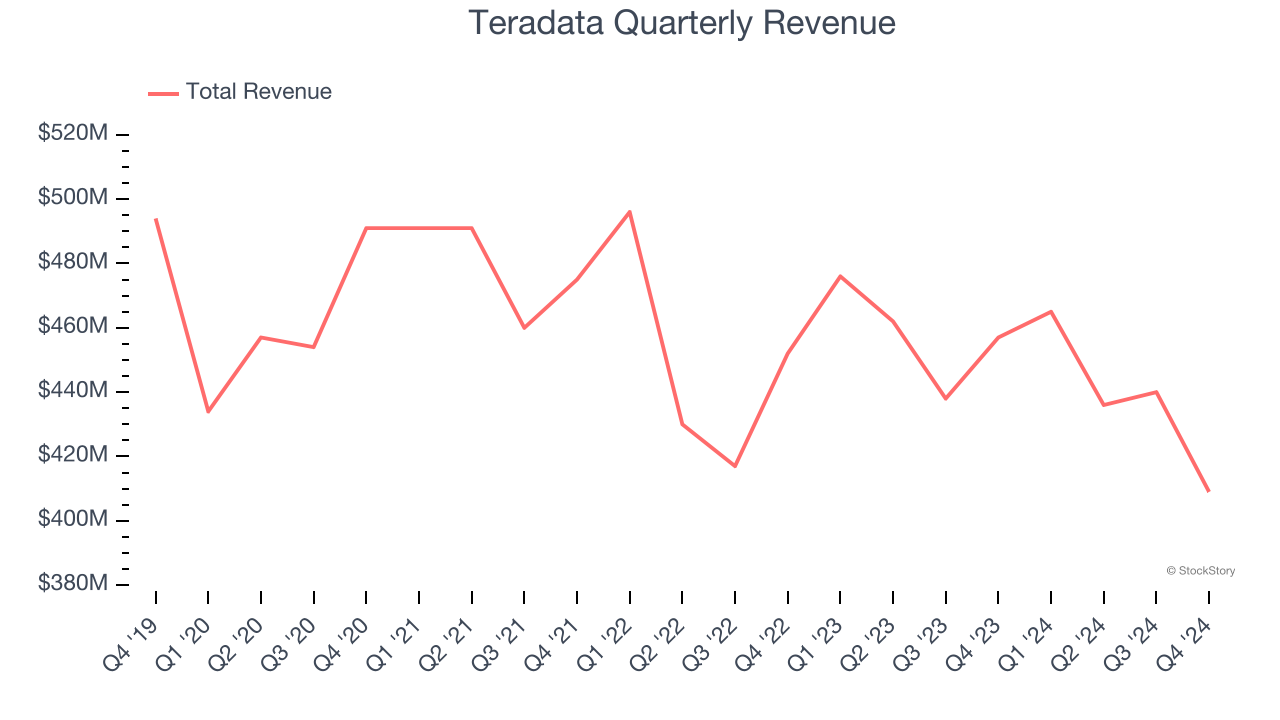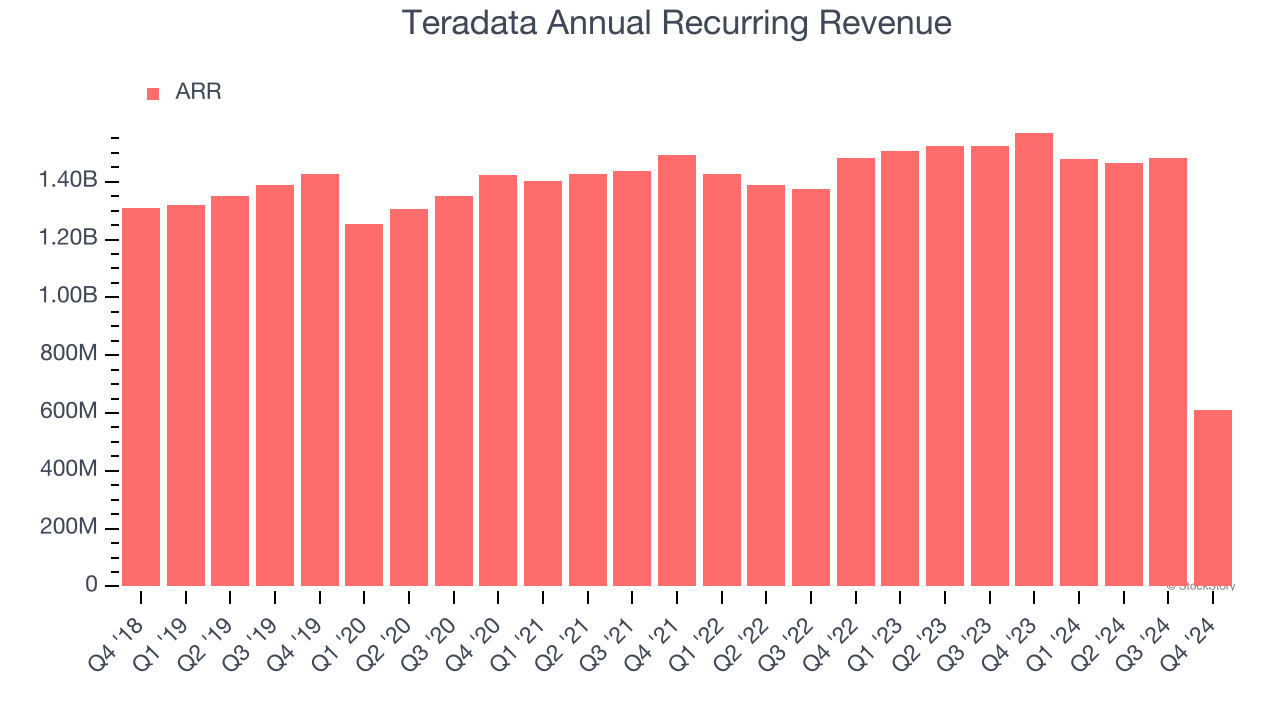
Data and analytics software provider Teradata (NYSE: TDC) missed Wall Street’s revenue expectations in Q4 CY2024, with sales falling 10.5% year on year to $409 million. Next quarter’s revenue guidance of $432.5 million underwhelmed, coming in 1.6% below analysts’ estimates. Its non-GAAP profit of $0.53 per share was 22.1% above analysts’ consensus estimates.
Is now the time to buy Teradata? Find out by accessing our full research report, it’s free.
Teradata (TDC) Q4 CY2024 Highlights:
- Revenue: $409 million vs analyst estimates of $415.3 million (10.5% year-on-year decline, 1.5% miss)
- Adjusted EPS: $0.53 vs analyst estimates of $0.43 (22.1% beat)
- Adjusted Operating Income: $72 million vs analyst estimates of $69.05 million (17.6% margin, 4.3% beat)
- Revenue Guidance for Q1 CY2025 is $432.5 million at the midpoint, below analyst estimates of $439.3 million
- Adjusted EPS guidance for the upcoming financial year 2025 is $2.20 at the midpoint, missing analyst estimates by 10.4%
- Operating Margin: 9.5%, in line with the same quarter last year
- Free Cash Flow Margin: 36.2%, up from 15.7% in the previous quarter
- Annual Recurring Revenue: $609 million at quarter end, down 61.2% year on year
- Market Capitalization: $2.96 billion
“In 2024, Teradata took decisive actions to improve execution, and met our guidance ranges for both Cloud and Total ARR. We believe we are well positioned to return to growth this year,” said Steve McMillan, President and CEO, Teradata.
Company Overview
Part of point-of-sale and ATM company NCR from 1991 to 2007, Teradata (NYSE: TDC) offers a software-as-service platform that helps organizations manage their data across multiple storages and analyze it.
Data Infrastructure
Generating insights from system level data is an increasing priority for most businesses, but to do so requires connecting and analyzing piles of data stored and siloed in separate databases. This is the demand driver for cloud based data infrastructure software providers, who can more readily integrate, distribute and process information vs. legacy on-premise software providers.
Sales Growth
Reviewing a company’s long-term sales performance reveals insights into its quality. Any business can have short-term success, but a top-tier one grows for years. Teradata struggled to consistently generate demand over the last three years as its sales dropped at a 3% annual rate. This fell short of our benchmarks and is a sign of poor business quality.

This quarter, Teradata missed Wall Street’s estimates and reported a rather uninspiring 10.5% year-on-year revenue decline, generating $409 million of revenue. Company management is currently guiding for a 7% year-on-year decline in sales next quarter.
Looking further ahead, sell-side analysts expect revenue to decline by 3.6% over the next 12 months, similar to its three-year rate. This projection is underwhelming and suggests its newer products and services will not lead to better top-line performance yet.
Here at StockStory, we certainly understand the potential of thematic investing. Diverse winners from Microsoft (MSFT) to Alphabet (GOOG), Coca-Cola (KO) to Monster Beverage (MNST) could all have been identified as promising growth stories with a megatrend driving the growth. So, in that spirit, we’ve identified a relatively under-the-radar profitable growth stock benefiting from the rise of AI, available to you FREE via this link.
Annual Recurring Revenue
While reported revenue for a software company can include low-margin items like implementation fees, annual recurring revenue (ARR) is a sum of the next 12 months of contracted revenue purely from software subscriptions, or the high-margin, predictable revenue streams that make SaaS businesses so valuable.
Teradata’s ARR came in at $609 million in Q4, and it averaged 17.4% year-on-year declines over the last four quarters. This alternate topline metric underperformed its total sales, which likely means that the recurring portions of the business are growing slower than less predictable, choppier ones such as implementation fees. If this continues, the quality of its revenue base could decline. 
Customer Acquisition Efficiency
The customer acquisition cost (CAC) payback period represents the months required to recover the cost of acquiring a new customer. Essentially, it’s the break-even point for sales and marketing investments. A shorter CAC payback period is ideal, as it implies better returns on investment and business scalability.
It’s relatively expensive for Teradata to acquire new customers as its CAC payback period checked in at 52.6 months this quarter. The company’s slow recovery of its sales and marketing expenses indicates it operates in a highly competitive market and must invest to stand out, even if the return on that investment is low.
Key Takeaways from Teradata’s Q4 Results
We struggled to find many positives in these results. Its full-year EPS guidance missed significantly and its revenue guidance for next quarter fell short of Wall Street’s estimates. Overall, this quarter could have been better. The stock traded down 12.5% to $27 immediately after reporting.
The latest quarter from Teradata’s wasn’t that good. One earnings report doesn’t define a company’s quality, though, so let’s explore whether the stock is a buy at the current price. What happened in the latest quarter matters, but not as much as longer-term business quality and valuation, when deciding whether to invest in this stock. We cover that in our actionable full research report which you can read here, it’s free.

